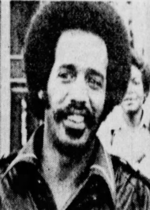 Associated Press, March 7, 1981. On May 13, 1972, a known drug dealer, Stanley Bryant, and his girlfriend were killed by shots from a sawed-off shotgun and a pistol in Oakland, California. In searching for suspects, the evidence led police to focus on Glenn Bailey. They also investigated 29-year-old Aaron Lee Owens, who had two previous felony convictions, including one for possession of a sawed off shotgun. Both Bailey and Owens were known for their involvement in dealing drugs. When a witness to the murder picked out a photo of Owens from a photo lineup and police discovered Bailey had called Owens’ house on the night of the murder, they believed they had found the killers. Police and the Alameda County Deputy District Attorney, John Taylor, gave little credence to Bailey’s claim that he did not know Owens and had called Owens’ house looking for Owens’ sister’s friend. Owens claimed that he had been shopping for Mother’s Day flowers at the time of the shooting, but he could only provide witnesses from his family to corroborate his claim since the flower shop salesperson did not recall whether Owens had been in the shop or not. Owens and Bailey were each convicted of two counts of first-degree murder and sentenced to life in prison by Alameda County Superior Court Judge Alan Lindsay. Both men were sentenced to San Quentin prison. According to Owens, he and Bailey got to know each other in prison, and, in 1978, Bailey told Owens the identity of his real accomplice. At Owens’ final parole hearing on January 3, 1980, Owens convinced the same Alameda County district attorney who had prosecuted him – John Taylor – of his possible innocence. Taylor, who was leaving the district attorney’s office for private practice, had merely dropped in on the parole hearing because he liked to keep tabs on his old cases and speak for or against parole when needed. The parole board turned down Owens’ parole request, but Taylor’s interest was piqued by Owens’ claims of innocence. “The same man who prosecuted me is the only one who would listen to me,” Owens later said in an interview. Taylor and Owens talked further after the hearing, and Taylor agreed to investigate Owens’ claims of innocence. Taylor began looking into the evidence from the 1972 crime and discovered that in 1979, Glenn Bailey had informed authorities that Owens had not been his accomplice. Taylor met with Bailey and Bailey gave Taylor the name of his true accomplice as well as new facts relating to that accomplice’s involvement that Taylor could verify independently. The person Bailey named as his true accomplice bore a striking resemblance to Owens. Based on the evidence compiled by Taylor, Judge Lindsay vacated Owens’ conviction and released him from prison on March 6, 1981, dismissing the charges against him. Stating that Owens’ innocence had been sufficiently proved, Lindsay added “we cannot repay your loss but we can say that the same system that convicted you (also) set you free.” Owens was greeted by his two daughters, then ages 13 and 14, upon his release. No warrant for Bailey’s true accomplice’s arrest was issued due to the lack of evidence nine years after the crime and to Bailey’s refusal to testify against him. In an interview two months after his release, Owens stated that he and John Taylor had “become close friends.” In February 1982, Owens filed a $10 million false imprisonment lawsuit against Alameda County for the county’s negligence and violations of Owens’ civil rights, though the final outcome of this lawsuit is unknown. - Meghan Barrett Cousino
|